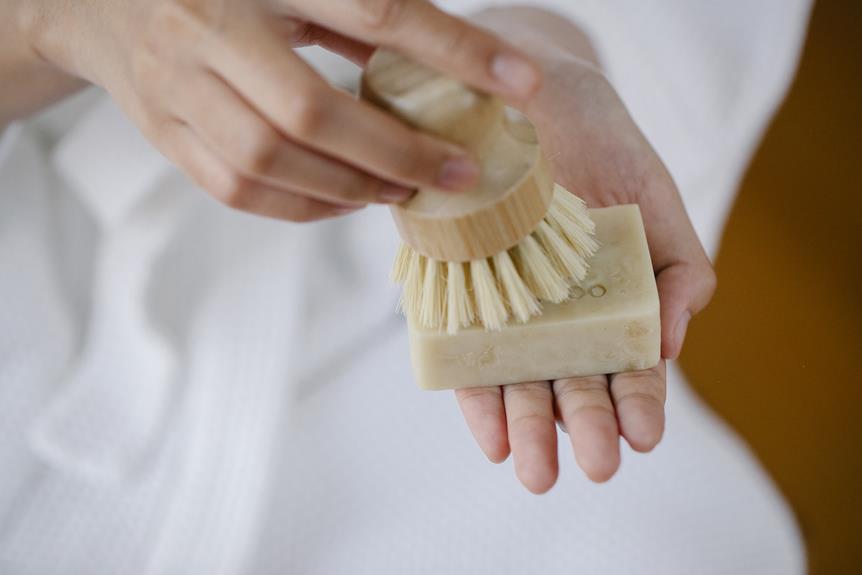What Is Woman Menstrual Hygiene and Sustainable Practices

In today’s world, the phrase ‘time of the month’ carries a deeper meaning beyond its literal interpretation. This article delves into the realm of woman menstrual hygiene and sustainable practices, shedding light on the environmental impact of traditional menstrual products and advocating for accessible alternatives.
By exploring the importance of education, awareness, and gender equality, we aim to serve an audience that desires to promote positive change while addressing taboos and stigmas surrounding menstruation.
Join us on this journey towards a more sustainable and inclusive future.
Key Takeaways
- Disposal of 20 billion menstrual hygiene products in the US annually contributes to waste generation and pollution, highlighting the need for sustainable alternatives.
- Menstrual cups and cloth pads made from organic cotton or bamboo are reusable and long-lasting alternatives that can significantly reduce waste and environmental impact.
- Education and awareness on menstrual hygiene play a crucial role in breaking taboos, empowering individuals to make informed choices, and promoting sustainable alternatives and waste reduction.
- Choosing sustainable menstrual products not only contributes to reducing waste and minimizing environmental footprint but also addresses affordability and ensures access to safe options, particularly for marginalized communities.
The Environmental Impact of Menstrual Hygiene Products
A comprehensive study conducted by the Environmental Protection Agency found that the annual disposal of approximately 20 billion menstrual hygiene products in the United States alone has a significant environmental impact. This alarming statistic highlights the need for sustainable practices when it comes to woman menstrual hygiene.
Traditional menstrual products, such as disposable pads and tampons, contribute to the growing problem of waste generation and pollution. Fortunately, there are more environmentally friendly alternatives available, such as menstrual cups and reusable cloth pads. These sustainable options not only reduce waste but also offer cost savings in the long run.
Sustainable Alternatives to Disposable Menstrual Products
One must consider the environmental impact when evaluating sustainable alternatives to disposable menstrual products. Menstrual cups and cloth pads are two such alternatives that not only reduce waste but also promote a healthier and more sustainable approach to menstrual hygiene.
Menstrual cups, made of medical-grade silicone, are reusable and can last for years, significantly reducing the amount of waste generated compared to disposable products.
Cloth pads, made from organic cotton or bamboo, are also reusable and can be washed and reused for several years.
These sustainable alternatives not only help reduce plastic waste and save resources but also promote a more natural and comfortable menstrual experience.
However, in order to fully embrace these alternatives, it is crucial to educate and create awareness about menstrual hygiene and the benefits of sustainable practices.
Transition: By promoting education and awareness on menstrual hygiene, individuals can make informed choices about sustainable alternatives and contribute to a healthier and more environmentally friendly future.
The Importance of Education and Awareness on Menstrual Hygiene
Education and awareness on menstrual hygiene play a crucial role in breaking the taboos surrounding menstruation. By providing accurate information and dispelling myths, we can empower individuals to make informed choices about their menstrual hygiene practices.
Promoting sustainable alternatives to disposable menstrual products is another important aspect of menstrual hygiene education. Raising awareness about sustainable menstrual product options can contribute to reducing waste and environmental impact.
Ensuring overall menstrual health is also a key focus of education and awareness efforts. By educating individuals about proper menstrual hygiene practices and addressing common health concerns related to menstruation, we can help promote healthier and more comfortable experiences for menstruators.
Breaking Menstrual Taboos
Many societies still perpetuate harmful and stigmatizing views surrounding menstruation, hindering progress in breaking menstrual taboos and achieving gender equality. In order to challenge these taboos and promote menstrual health education, it is crucial to address the misconceptions and cultural norms that perpetuate shame and silence around menstruation.
Breaking taboos requires a comprehensive approach that includes providing accurate information about menstrual health and hygiene, promoting open conversations, and challenging the social constructs that undermine women’s rights and well-being.
Menstrual health education plays a pivotal role in empowering women and girls to manage their periods safely and confidently. By equipping them with knowledge about menstrual hygiene products, proper disposal methods, and sustainable practices, we can help eliminate the stigma and ensure that menstruation is no longer a barrier to gender equality.
Sustainable Menstrual Product Alternatives
In order to promote sustainable menstrual product alternatives, it is essential to raise awareness and provide education on the importance of menstrual hygiene. Sustainable menstrual products, such as reusable period products, offer numerous benefits for both the environment and women’s health.
Here are four reasons why these alternatives are worth considering:
- Environmental Impact: By using reusable period products like menstrual cups, women can significantly reduce the amount of waste generated from disposable products, which often end up in landfills or pollute waterways.
- Cost-effectiveness: Reusable period products are a one-time investment that can last for years, saving women money in the long run compared to constantly buying disposable products.
- Health Benefits: Menstrual cups, for example, are made of medical-grade silicone, which is safe and hypoallergenic. They also reduce the risk of toxic shock syndrome associated with tampon use.
- Convenience: Once inserted correctly, menstrual cups can be worn for up to 12 hours, providing long-lasting protection and allowing women to go about their daily activities without interruptions.
Promoting Menstrual Health
Efficiently raising awareness about menstrual health is crucial for improving women’s well-being and ensuring proper menstrual hygiene practices. Menstrual health education plays a vital role in empowering women and girls to make informed decisions about their reproductive health. Menstrual health campaigns are essential in breaking the stigma surrounding menstruation and promoting menstrual hygiene practices. These campaigns aim to provide accurate information about menstruation, debunking myths and misconceptions, and encouraging open discussions about this natural process. To illustrate the significance of menstrual health education and campaigns, the following table showcases the impact of these initiatives:
| Benefits of Menstrual Health Education and Campaigns |
|---|
| Increased awareness about menstrual health and hygiene |
| Reduction in the use of unsafe menstrual products |
| Improved access to menstrual products and facilities |
| Empowerment of women and girls to manage their menstruation confidently |
| Enhanced overall well-being and quality of life |
Advocating for Accessible and Affordable Sustainable Menstrual Products
Advocating for accessible and affordable sustainable menstrual products is crucial for addressing the challenges faced by individuals who menstruate.
One key point to consider is the cost of sustainable options, as many people may not have the financial means to purchase expensive alternatives.
Additionally, promoting environmentally friendly alternatives can help reduce the environmental impact of disposable menstrual products.
Lastly, it is essential to ensure that these sustainable options are accessible to marginalized communities who may face additional barriers in accessing menstrual products.
Cost of Sustainable Options
The affordability of sustainable menstrual products remains a key consideration in promoting accessible and equitable menstrual hygiene practices. Many women face affordability issues when it comes to accessing sustainable options. Here are four points to consider:
- Cost comparison: Sustainable menstrual products such as menstrual cups or cloth pads may have a higher upfront cost compared to disposable products. However, they can provide long-term savings as they can be reused for several years.
- Financial constraints: Affordability issues can disproportionately affect low-income individuals who may struggle to afford the initial investment in sustainable products.
- Environmental impact: Choosing sustainable menstrual products not only benefits the individual but also contributes to reducing waste and minimizing the environmental footprint.
- Health benefits: Sustainable options are often made from non-toxic materials, reducing the risk of irritation or allergic reactions.
Addressing the affordability of sustainable menstrual products is crucial in ensuring that all individuals have access to safe and environmentally-friendly menstrual hygiene options.
Environmentally Friendly Alternatives
While considering the financial constraints faced by low-income individuals, it is important to explore environmentally friendly alternatives for menstrual hygiene that are both accessible and affordable.
One such alternative is the menstrual cup, which offers numerous benefits. Menstrual cups are reusable, reducing the amount of waste generated compared to disposable pads and tampons. They are made of medical-grade silicone, making them safe and comfortable to use. Additionally, menstrual cups can be worn for up to 12 hours, providing long-lasting protection.
In terms of affordability, a menstrual cup can last for several years, saving women a significant amount of money in the long run.
Accessibility for Marginalized Communities
Many marginalized communities lack access to affordable and sustainable menstrual products, hindering their ability to manage their menstrual hygiene effectively. This issue is especially prevalent in places such as schools and prisons, where individuals may face additional challenges in accessing these essential products.
The lack of access to menstrual hygiene products can have significant negative consequences for individuals, including health risks, embarrassment, and decreased self-esteem.
To evoke an emotional response in the audience, consider the following list:
- Students missing school due to the inability to manage their menstrual hygiene effectively.
- Women in prisons resorting to unhygienic and unsafe alternatives during their periods.
- The stigma and shame experienced by individuals who cannot afford menstrual products.
- The impact on mental health and overall well-being due to the lack of access to menstrual hygiene products.
It is crucial to address these issues and find sustainable solutions to ensure that all individuals have access to affordable and sustainable menstrual products, regardless of their socioeconomic status or environment. By prioritizing menstrual hygiene in schools and prisons, we can promote dignity, health, and equality for all.
Menstrual Hygiene and Public Health: Addressing Taboos and Stigmas
Addressing taboos and stigmas surrounding menstrual hygiene is crucial in promoting public health, as it allows individuals to access accurate information and necessary resources for managing their menstrual health. Menstrual stigma often leads to misinformation and limited access to proper menstrual hygiene products, which can have serious consequences on women’s health. By challenging these taboos and stigmas, we can create a supportive environment that fosters menstrual health education and empowers individuals to make informed decisions about their own bodies.
In order to understand the impact of addressing menstrual stigma, let’s take a look at a comparison between two scenarios:
| Scenario 1: Menstrual Stigma Present | Scenario 2: Menstrual Stigma Addressed |
|---|---|
| Limited access to menstrual hygiene products | Increased availability of affordable and sustainable menstrual products |
| Lack of knowledge about menstrual health | Comprehensive menstrual health education |
| Shame and embarrassment associated with menstruation | Open conversations and positive attitudes towards menstruation |
Sustainable Menstrual Practices: A Step Towards Gender Equality
The implementation of sustainable menstrual practices is a crucial step towards achieving gender equality. By addressing the issue of menstrual hygiene, we can empower women and girls to lead healthier and more productive lives.
Here are four reasons why sustainable menstrual practices are important:
- Socioeconomic impact: Lack of access to menstrual products can lead to absenteeism from school and work, limiting opportunities for education and economic empowerment.
- Health and well-being: Proper menstrual hygiene reduces the risk of infections and other health complications, ensuring the overall well-being of women and girls.
- Cultural implications: Menstruation taboos and stigma can perpetuate discrimination and inequality. Sustainable menstrual practices can challenge these cultural norms and promote inclusivity and acceptance.
- Environmental sustainability: Disposable menstrual products contribute to waste and pollution. Switching to sustainable options like reusable pads or menstrual cups can help protect the environment.
Promoting Menstrual Hygiene in Developing Countries: Challenges and Solutions
One of the key challenges in promoting menstrual hygiene in developing countries is the lack of access to affordable and safe menstrual products. This issue poses significant hurdles in implementing menstrual hygiene programs and promoting sustainable practices.
Cultural barriers to menstrual hygiene promotion also contribute to the challenges faced in these countries. In many societies, menstruation is considered taboo, and the topic is surrounded by stigma and shame. This leads to a lack of education and awareness about menstrual hygiene, further hindering progress in this area.
To overcome these challenges, it is crucial to address the cultural beliefs and norms surrounding menstruation, and provide comprehensive education on menstrual health and hygiene. Additionally, efforts should be made to increase the availability and affordability of menstrual products, ensuring that they are safe and sustainable.
Frequently Asked Questions
What Are the Different Types of Sustainable Menstrual Products Available on the Market?
There are several eco-friendly alternatives for menstrual products available on the market, including menstrual cups, reusable cloth pads, and period underwear. These options provide sustainable and environmentally-friendly options for managing menstruation.
How Can Individuals Ensure the Proper Disposal of Reusable Menstrual Products?
Proper disposal of reusable menstrual products is crucial to maintain hygiene and sustainability. Individuals can ensure this by following local regulations, using designated bins or composting systems, and educating others about the importance of responsible disposal.
What Are Some Common Misconceptions or Myths Surrounding Menstrual Hygiene?
Common misconceptions surrounding menstrual hygiene include menstrual hygiene stigma and cultural practices that perpetuate shame and discrimination. These misconceptions hinder access to proper menstrual care and perpetuate harmful beliefs about menstruation.
How Can Schools and Communities Promote Education and Awareness on Menstrual Hygiene?
Promoting menstrual hygiene education is crucial for schools and communities. By organizing awareness campaigns, they can empower individuals with knowledge about menstrual hygiene practices, debunk myths, and create a supportive environment for women and girls.
What Are Some Challenges Faced in Providing Accessible and Affordable Sustainable Menstrual Products in Developing Countries?
In developing countries, challenges arise in providing accessible and affordable sustainable menstrual products. These obstacles include limited resources, lack of infrastructure, and cultural taboos. However, through collaborative efforts and innovative solutions, progress can be made to overcome these challenges.









